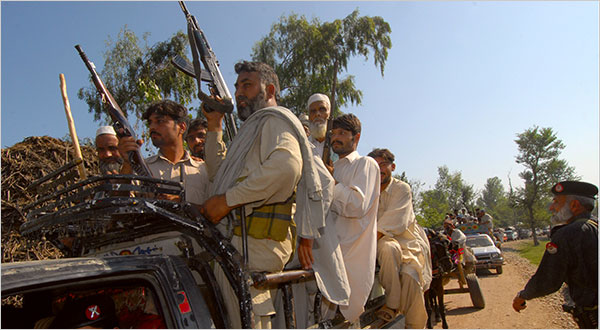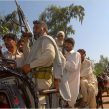The Role of Tribal Lashkars in Winning Pakistan’s War on Terror
Publication: Terrorism Focus Volume: 5 Issue: 40
By:

After successive failed attempts to tackle the rising militancy in Pakistan’s Federally Administered Tribal Areas (FATA) and the adjoining North-West Frontier Province (NWFP), Pakistan’s new civilian government is now encouraging local tribal people to stand up against the Taliban and al-Qaeda and flush them from their regions. The government is hopeful that the tradition of tribal lashkars will evict militants from the region, or at least isolate al-Qaeda and weaken the roots of the Taliban. The lashkar is a traditional tribal militia, often formed on an ad hoc basis for the accomplishment of a specific purpose. The forming of tribal militias is not something new in the history of FATA, but this time it has shown some positive results, partly because it is backed by the “will” of the tribal folk who have become fed up with Taliban atrocities.
The most noteworthy and unprecedented anti-Taliban uprising to date took place in the Buner district of the NWFP, where villagers raised an armed squad of volunteers and killed a group of six militants who had attacked a police station in the Kingargalli area of the district and brutally killed eight policemen (The News [Islamabad], August 31). Since then, other armed lashkars in the Frontier province and tribal region bordering Afghanistan have been encouraged to hunt for Taliban militants.
Every tribesman in the lashkar is armed with his own weapon, food and supplies. Normally, the government does not assist such lashkars either financially or logistically. Typically, lashkars are formed to hunt down an outlaw, address a family feud that has grown out of control, or sometimes even challenge a particular government policy. They are assembled for the resolution of a particular issue and then disbanded. In general, the tribal lashkars have a good track record of bringing peace and order to their wild land, but they twice failed to expel al-Qaeda fighters from the tribal region in 2003 and 2007, when big lashkars with thousands of volunteers were formed in South Waziristan. The organizers of these lashkars were further discouraged when the Taliban began targeting all those tribal elders who had been part of the militias. Since then, more than 300 tribal elders have been killed in targeted killings in the tribal belt alongside the Afghanistan border, stretching from South Waziristan to the Bajaur area (Aaj TV, October 28).
This time, however, the increasing brutality of the Taliban (which now includes murder, kidnappings of local people, the torching of girls’ schools, and the bombing of CD shops) has frustrated local tribals to such an extent that they have started a genuine and indigenous resistance movement to get rid of all militants in the area. In the past, the fear of Taliban reprisals and uncertainty about the sincerity of the government and military’s commitment to fighting militancy prevented the communities from challenging the militants.
This resistance movement has some parallels with the Sunni “Awakening” movement in al-Anbar province of Iraq, where tribesmen rose up against al-Qaeda militants and successfully evicted them from the area. But there are also some major differences between these two movements. In Iraq, the Sunni tribes were assisted with millions of dollars from the U.S. government as well as active military support. In contrast, the tribal lashkars in Pakistan are so far relying on their own old-fashioned guns against the sophisticated weapons of Taliban and al-Qaeda (Daily Mashriq [Peshawar], October 25).
Lakki Marwat was the first district in the NWFP to raise a volunteer lashkar to evict Taliban militants from the area. The Taliban were warned by the elders of the lashkar to surrender or face the consequences. The local Taliban did not dare to face up to the large lashkar, and as a result they either gave up their militant activities or left the area. (Newsline [Karachi], October 2008). The same encouraging results were achieved in another district of the province, Hangu, where the Taliban did not put up much resistance and evacuated the area. However, it was in Buner district where the lashkars achieved unprecedented results, inviting attention from the rest of the tribal area.
Soon several such lashkars were formed in the nearby Bajaur tribal area, adjacent to Swat, where tribesmen have suffered at both the hands of the Taliban and through successive military operations. A lashkar of 4,000 armed men raised by the Salarzai tribe launched a campaign against the militants, attacked their strongholds and destroyed their houses and so-called “command centers” in the Bajaur tribal region. Lashkar leaders warned local and foreign militants of dire consequences if they did not leave the area. Malik Munasib Khan, who is leading the uprising against the militants, said that the houses destroyed by the volunteers included one belonging to militant leader Naimatullah, who had occupied several government schools and converted them into madrassas (Dawn [Karachi], September 1). Volunteers of the Salarzai tribe set fire to eight Taliban houses in the Aundai area and killed three militants. Under pressure, the Taliban leadership began directing their supporters to trim their beards and long hair (Taliban hallmarks in the tribal areas) to avoid recognition (Daily Times [Lahore], October 5). The lashkars had some gains in Kurram agency as well, where they captured the Bagzai area, a stronghold of the Taliban, with six militants killed and 26 others injured. The local lashkar then retook control of the Char Dewal and Jalmai villages from the Taliban. After further defeats of the Taliban in various parts of the Kurram agency, the tribal volunteers plugged all access points to prevent further entry of unwanted elements into the agency (Geo TV, September 2).
In some areas, the Taliban reacted swiftly and brutally to the challenge posed by the tribal lashkars. In Bajaur, the Taliban beheaded four elders from the Charmang as they returned home after attending a jirga convened to plan action against the Taliban (Daily Times, October 11). In another incident in the same tribal area, 22 tribesmen were killed and 45 injured when a suicide bomber blew himself up at a Salarzai jirga where members of the lashkar were finalizing their strategy after demolishing houses belonging to Taliban fighters. Over 100 people were killed in a suicide attack on an Orakzai Agency jirga which had been convened to form a lashkar to clampdown on local Taliban activities (Daily Times, November 7). This particular bombing reflected the new intensity of the struggle between Taliban militants and tribal forces – previously, the Orakzai Agency had been considered the most peaceful of the seven agencies making up FATA.
There is no doubt that the tribal lashkars have delivered by flushing Taliban fighters from some parts of the tribal areas, as well as evicting them from certain settled districts of the NWFP. It is also a fact that this time, it is not just a mere display but a real and genuine indigenous movement against the militants who have created major problems for the local tribes. The tribesmen became fed up with Taliban brutality and could not endure their activities any longer. Unfortunately, the mobilization of the lashkars is not likely to be enough to halt the Pakistani Taliban. Despite some significant gains by the lashkars, there seems to be no stopping the Taliban in Swat, Khyber Agency, Waziristan, Kohat district and other parts of the NWFP and FATA. It is also widely feared that the anti-Taliban lashkars could cause further violence and sow the seeds of unending tribal feuds which could turn into a civil war-like disaster. Another fear is that the accumulation of too much power and weapons in their hands will allow the lashkars to grow out of control and turn to warlordism, creating a new range of problems to replace those posed by the Taliban.





